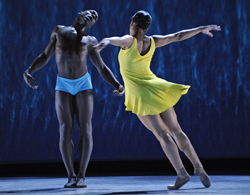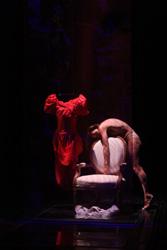New dances set to new music: the quartet of commissions celebrating Ballet British Columbia’s twenty-fifth anniversary were very contemporary in their restless explorations of the body in theatrical motion. Artistic director Emily Molnar invited two of Vancouver’s most high-profile independent choreographers, Wen Wei Wang and Serge Bennathan, to create works for the occasion, as well as Ballet BC dancer Donald Sales and independent, Montréal-based Gioconda Barbuto.
All four pieces had inventive vocabularies built, for the most part, from the not uncommon mix of “high” (virtuosic ballet steps), “ “mid-range” (expressive modern dance) and “low” (gymnastic flips, pedestrian running or standing, or other non-dance moves like throwing the arm out as if tossing a ball). These works, presented at the Queen Elizabeth Theatre, were very twenty-first century in their egalitarian mixes: this wasn’t ballet with a bit of this and that thrown in, so much as a mash-up where everything is equal. The focus on invention created the evening’s overarching theme: the evolving style and presence of ballet itself. That, at least, is how it seemed to me, with the future of the art form much on my mind following Jennifer Homans’ dire predictions of its growing irrelevance in “Apollo’s Angels: A History of Ballet”.
Wang’s opening piece, “In Motion”, was described in the program note as being “a relationship between sound and movement, musicians and dancers.” In the best Balanchine tradition, Wang’s fifteen dancers (the whole company, including one apprentice) respond to Owen Underhill’s score, “Geometry of Harmony”, played live by Turning Point Ensemble. The eight musicians sit upstage, backs to the audience: we see the large white pages of their scores and, unusually, the face of the conductor, Underhill himself, directing them in the gloom. The ten sections of Underhill’s 2001 composition range from sparse and postmodern to lush, almost jazzy tunes; the dancers’ musical responses – their steps and timing — are intense but not symbiotic, with some of the choreography danced in silence as if to underscore its independence. These bodies — in sheer, grey tunics by Kate Burrows — illuminate the music while also having their own creative arc: in formal terms, this is surely ballet’s ideal.
The buzz at intermission was all about the duet between Gilbert Small and Dario Dinuzzi, a muscular romantic coupling set beside the equally muscular and romantic violin of Mary Sokol Brown, who stands nearby. There’s an equal force between the two men that is appealing — they tumble and flip in intimate proximity that has an erotic, gymnastic edge. “In Motion” is otherwise quite chaste, though not dry: its juicy classicism is busy and bustling; friendly, too, in an efficient, urban way. It’s the evening’s only pointe ballet, and this heightened physicality allows Wang to maximize line and flow. Yet that technical tool is perhaps the greatest stylistic conundrum of ballet in the twenty-first century: as long as pointe shoes are on the feet of women only, ballet will never reflect the typically more equal relationships between contemporary couples. It will also continue to present a stereotypical vision of the world that ignores the wider expression of gender we see today.
Bennathan’s “Les chercheurs de dieu” followed, with a choreographic impulse that is strong and clear throughout. Sections of silence and/or breath again underline the independence of dance from music, though the piece was well supported by Michael Oesterle’s “Counting Games for Julia Robinson”. The score for trombone and ensemble was a new commission by Turning Point, who played in the pit for this and the following pieces. Bennathan’s rounded, tumultuous bodies, half-hidden in Linda Chow’s baggy T-shirts and cargo pants, appear less as individuals than as a tribe of post-civilization survivors (the movement is too historically rooted for a pre-civilization tribe). Their fingers, alive and trembling; their skittering, low arabesques forward or around in circles; their too-big steps, as if they’re children wearing adult-size shoes: these bodies ooze unpredictable, sometimes virtuosic, sometimes pedestrian, movement. The piece ends on a kind of sneeze that moves smoothly through the entire tribe — a Rabelaisian explosion of inner fluids or, perhaps, of inner spirit?
After a second intermission, the final third of the program was given over to the two shorter pieces. First, Donald Sales’ “Moth”, set to music by David Lang (the only non-Canadian composer of the evening) and Underhill. “Moth” is memorable for its stage full of candles, providing warm flickering light in which one male and five female dancers hurry about in a wild mix of moves that reminded me of Kevin O’Day’s “Face to Face”, which the company danced last year.
Sales’ program note refers to his personal experience of grief over a sibling’s death, but I didn’t read this till later, and experienced the piece through the imagery suggested by the title and the candles — something about moths driven to the flame. Toward the end, Maggie Forgeron sat at the side of the stage signing, and while the specific meaning of her gestures would be known to only a few, her dramatic presence invested the movement with emotional resonance.
I have to say I was beat by the time Barbuto’s “TOUCH” took the stage — the fourth ensemble piece to contemporary orchestral music – and so fell into a reverie to Anthony Genge’s beautiful, when-worlds-collide score, “The Human Condition”, another musical premiere. “TOUCH” seemed to be about exploring just what the title says but, like the earlier pieces, this was presented in formal aesthetic terms rather than through interpersonal relationships. A visual delight came when one dancer, held sideways in the air, stepped lightly up the side of the torso and the length of the raised arm of the dancer standing beside her.
The evening was certainly cohesive, with all the pieces vividly lit by James Proudfoot (who needs set design — there wasn’t any — when he’s around?), and with live music — by the always taut and finely detailed musicianship of Turning Point — contributing a sense of occasion to this anniversary celebration. I went twice, and enjoyed Saturday even more than opening night: the dancers were more relaxed, sound levels were more even and I was less driven to “get” each piece as it raced by. I simply entered the four worlds and let them reveal themselves through style and presence: no doubt too conservatively for some, too progressively for others. That’s the dilemma of ballet today as it struggles worldwide to hold on to its established audience while also trying to win over a contemporary crowd who need to see their social and political dreams and realities reflected in art.
Tagged: Ballet, Contemporary, Performance, BC





